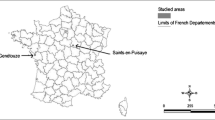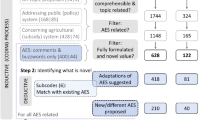Abstract
At its beginning, the European Union’s Common Agricultural Policy (CAP) did not include measures to guide farmers in preserving ecosystems. At the same time, the social context on the 1960s and 1970s did not encourage environmental care to become a priority. Since the 1980s, new social concern expressed alarm over ecology, recognizing that agriculture can pollute. These social changes moved the CAP to add measures that linked agriculture and environment. In order to study if the EU decision-makers have designed a CAP which responds to a new ethic that incorporates environmental care and social demands, two questions rise: whether the social image of agriculture as a polluting activity has changed; and whether farming performs the environmental functions demanded by society. To answer the previous questions, we have reviewed the environmental aspects added to the CAP, then a poll has been conducted and cluster method and classification tree models have been used to group respondents according to their opinions. The results show that the society ascribes great relevance to the environment for the future sustainability of the region, but they are not satisfied with the role of agriculture in producing environmental outputs.







Similar content being viewed by others
Notes
The sample size was calculated for estimation of proportion, with a sampling error of 5% (Confidence interval = 95%; and p = q = 0.50). The sample size was based on Arkin y Colton (1962).
For more methodological information on the multivariate cluster technique, see Chatfield and Collins (1980).
The term “post-materialsim” emerged by Ingleharts (1971) in The Silent Revolution in Europe: Intergenerational Change in Post-Industrial Societies.
The Uruguay Round within the framework of the General Agreement on Trade and Tariffs (GATT), tending towards the liberalization of international trade, began in 1986.
The Accompanying Measures were: afforestation of agricultural lands, pre-retirement scheme, and agri-environmental action program.
The Focus Groups are dynamics organized with groups of selected people that allow us to pick up the diverse perspectives existing in relation to a subject and the general group view.
Abbreviations
- CAP:
-
Common agricultural policy
- EU:
-
European union
- GDP:
-
Gross domestic product
- UAA:
-
Usable arable area
- INE:
-
Instituto Nacional de Estadística
- GATT:
-
General agreement on trade and tariffs
- RDP:
-
Rural development policy
- EAFRD:
-
European agricultural fund for rural development
- PBI:
-
To preserve biodiversity
- CSE:
-
To control erosion and soil loss
- WAT:
-
To maintain water quality and improve the water-resource management
- LAN:
-
To preserve and enhance the agricultural landscape
References
Arkin, H., & Colton, R. (1962). Tables for statisticians. New York: Barnes and Noble.
Breiman, L. J., Friedman, J., Olshen, R. A., & Stone, C. J. (1984). Classification and regression trees. New York: Chapman and Hall/CRC.
Buckwell, A. (1996). Transformación de la PAC en una política rural más integrada. Rev Esp de Econ Agrar 176–177, 13–38.
Chatfield, C., & Collins, A. J. (1980). Introduction to multivariate analysis. New York: Chapman and Hall.
Consejería de Agricultura y Pesca. (2000). Plan de Modernización de la agricultura andaluza. Sevilla: Junta de Andalucía.
Cooper, T., Baldock, D., & Farmer, M. (2007). Toward the CAP health check and the European budget review. Washington, DC: Institute for European Environmental Policy.
European Commission. (1985). Perspectives for the common agricultural policy. COM (85) 333, Brussels.
European Commission. (1988a). European and their agriculture. Eurobarometre special issue. Brussels: Directorate-General for Agriculture.
European Commission. (1988b). The future of rural society. COM 501 final, Brussels.
European Commission. (1991). The development and future of the common agricultural policy. Follow-up to the Reflections Paper. COM (91) 258 final, Brussels.
European Commission. (1999a). For a stronger and wider union. Agenda 2000. COM 2000 final, Brussels.
European Commission. (1999b). Council regulation (EC) 1257/99, 17 May. Official Journal of the European Union L 160, 26 June, Brussels.
European Commission. (2003). A long-term policy perspective for sustainable agriculture. COM (2003) 23, Brussels.
European Commission. (2005). Agriculture in the European Union: Statistical and economic information 2004. Brussels: Directorate-General for Agriculture and Rural Development.
European Commission. (2008). Europeans, agriculture and the Common Agricultural Policy Eurobarometre n° 294, Directorate-General for Agriculture and Rural Development, Brussels.
European Commission. (2009). Council Decision about modification of 2006/144/CE Decision, Community strategic guidelines for rural development (programming period 2007–2013). Official Journal of the European Union L 30/112, 31 January, Brussels.
Fraser, R. (2009). Land heterogeneity, agricultural income forgone and environmental benefit: An assessment of incentive compatibility problems in environmental stewardship schemes. Journal of Agricultural Economics, 60, 190–201.
Gay, S. H., Osterburg, B., Baldock, D., Zdanowicz, A. (2005). Recent evolution of the EU Common Agricultural Policy (CAP): State of play and environmental potential. Working paper MEACAP WP6 D4b.
Hall, C., McVittie, A., & Moran, D. (2004). What does a public want from agriculture and the countryside? A review of evidence and methods. Journal of Rural Studies, 20, 211–225.
Harvey, D. (1990). The CAP and green agriculture. London: Institute for Public Policy Research.
Hyytiä, N., Kola, J. (2005). Citizens′ attitudes towards multifunctional agriculture. Discussion Paper N° 8, Agricultural Policy. Helsinki University.
INE-Spanish Statistical Institute. (2007). Censo de población y vivienda 2001 (resultados detallados). Madrid. Available via: www.ine.es. Accessed Sep 2007.
INE-Spanish Statistical Institute. (2008). Datos estadísticos. Madrid. Available via: www.ine.es. Accessed June 2008.
Inglehart, R. (1971). The silent revolution in Europe: Intergenerational change in post-industrial societies. The American Political Science Review, 65(4), 991–1017.
Marsh, J., & Tarditi, S. (2003). Cultivating a crisis: The global impact of the common agricultural policy. Brussels: Consumers International and European Research into Consumer Affairs.
Massot, A. (2003). La Reforma de la PAC 2003: Hacia un modelo de apoyo para las explotaciones agrarias. Rev de Estad Agrosoc y Pesqueros, 199, 11–60.
Matson, P. A., Parton, W. J., Power, A. G., & Swift, M. J. (1997). Agricultural intensification and ecosystem properties. Science, 277, 504–509.
Morgan, J. N., Messenger, R. C. (1973). A sequential analysis program for the analysis of nominal scale dependent variables. Institute for Social Research, University of Michigan.
Mosnier, C., Ridier, A., Képhaliacos, C., & Carpy-Goulard, F. (2008). Economic and environmental impact of the CAP mid-term review on arable crop farming in South-western France. Ecological Economics, 68, 1408–1416.
OECD. (1994). Territorial indicators of employment. Paris: Focusing on rural development.
Potter, C., & Burney, J. (2002). Agricultural multifunctionality in the WTO- legitimate non-trade concern or disguised protectionism? Journal of Rural Studies, 18, 35–47.
Puerta, A. (2002). Imputación basada en árboles de clasificación. Eustat, Instituto Vasco de Estadística, San Sebastián.
Schmid, E., Sinabell, F., & Hofreither, M. (2007). Phasing out of environmentally harmful subsidies: Consequences of the 2003 CAP reform. Ecological Economy, 60, 596–604.
Sonquist, J. A., Morgan, J. N. (1964). The detection of interaction effects: A report on a computer program for the selection of optimal combinations of explanatory variables. Institute for Social Research, University of Michigan.
Acknowledgments
This research was financed by the Instituto Nacional de Investigación y Tecnología Agraria y Alimentaria (INIA) and the FEDER Founds of the European Union (EU) through the research project MULTIPREF (RTA2006-00055). The authors wish to express their gratitude for the economic support received. We would like to thank the anonymous reviewers of an earlier version of this paper for their helpful comments.
Author information
Authors and Affiliations
Corresponding author
Rights and permissions
About this article
Cite this article
Salazar-Ordóñez, M., Sayadi, S. Environmental Care in Agriculture: A Social Perspective. J Agric Environ Ethics 24, 243–258 (2011). https://doi.org/10.1007/s10806-010-9255-5
Accepted:
Published:
Issue Date:
DOI: https://doi.org/10.1007/s10806-010-9255-5




